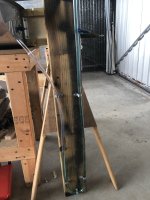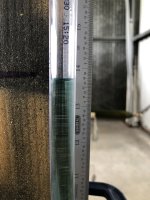Those with more experience, I have completed one tank on my 10. Let it cure for a week and am doing balloon Test now. When I first pressured it up I used a soapy spray bottle and couldn’t find any leaks. My balloon has slowly gotten smaller over the last couple days. How do I track down a leak if it’s so slow I’m not finding it with soap? Or could this be a weather changing thing?
Van's Air Force
You are using an out of date browser. It may not display this or other websites correctly.
You should upgrade or use an alternative browser.
You should upgrade or use an alternative browser.
Tank testing
- Thread starter Cholley6
- Start date
Temperature change will greatly affect the balloon. Another factor is the porosity of the balloon. One test is to have another balloon from the same batch blown up to the same size as the one on the tank. Without a tank leak, they should remain about the same size.Those with more experience, I have completed one tank on my 10. Let it cure for a week and am doing balloon Test now. When I first pressured it up I used a soapy spray bottle and couldn’t find any leaks. My balloon has slowly gotten smaller over the last couple days. How do I track down a leak if it’s so slow I’m not finding it with soap? Or could this be a weather changing thing?
could be the weather if higher pressure has moved in. watch your barometer and tank. i finally filled my tank under a canopy outside with fuel and watched it for several days.
after i was done and had drained the tank i ran an aquarium air pump into for a few more days. couldn't even smell gas in the tank after that
after i was done and had drained the tank i ran an aquarium air pump into for a few more days. couldn't even smell gas in the tank after that
Quick update, tank is in my garage and after getting back from a couple errands this morning I left the garage open about 15 minutes. I watched the balloon shrivel much more very quickly. A front came through yesterday so I think temperature and pressure is very likely what I’m seeing.
OneTwoTree
Member
Balloons are porous and leak air. Think about how your balloons lost air when you were a kid. You figured they would stay inflated forever, but after a couple of days you were dismayed to find they were much smaller, or completely empty.Those with more experience, I have completed one tank on my 10. Let it cure for a week and am doing balloon Test now. When I first pressured it up I used a soapy spray bottle and couldn’t find any leaks. My balloon has slowly gotten smaller over the last couple days. How do I track down a leak if it’s so slow I’m not finding it with soap? Or could this be a weather changing thing?
D-Dubya
Well Known Member
I made a manometer type tester at the suggestion of a more experienced builder, for the very reasons the others are listing about balloons losing air. I put some food dye in water to make colored water in a clear vinyl tube and clipped it onto a board. It was sensitive enough that the level would go up and down as the air conditioner cycled on and off in the shop--but it stayed within a specific range for several days.
Last edited:
[email protected]
Well Known Member
I've built more that a tank or two. The last set I built two years ago for my RV-6, I did the balloon test and watched the weather for the usual.
They both tested for a week (must of had good balloons) and still had air as installed. Painted and installed them.
So they don't leak RIGHT? WRONG again. They do not leak liquid fuel as such, But, under the vinyl wrap they are pushing vapor causing bubbles in the vinyl of up to an inch in diameter on about 15 rivets. No fuel stains anywhere or out of the bubbles if I pop them.
All the rivets not covered by vinyl show no leakage.
My luck sure has been varying. FIXIT
They both tested for a week (must of had good balloons) and still had air as installed. Painted and installed them.
So they don't leak RIGHT? WRONG again. They do not leak liquid fuel as such, But, under the vinyl wrap they are pushing vapor causing bubbles in the vinyl of up to an inch in diameter on about 15 rivets. No fuel stains anywhere or out of the bubbles if I pop them.
All the rivets not covered by vinyl show no leakage.
My luck sure has been varying. FIXIT
bruceh
Well Known Member
I've built several tanks, and fixed leaks on about a dozen more. I've used the manometer set up successfully. The water level will rise and fall as others have said, but if they are still at different levels overnight, they are probably leak free. I say probably, because I have had to come back and fix my repairs on more than one occasion. Sometimes it is weeks/months later. It can be very frustrating. Just take this as a data point. No matter if the tank appears to be leak free, there are no guarantees in life. Fuel will find a way!
rocketman1988
Well Known Member
I find that Camco gas leak fluid works much better than soap and water.
I too used a manometer, as others have mentioned. The change in water level, after converting the pressure from inches of mercury to inches of water, tracked atmospheric pressure very nicely. After a couple of days I called it good.






